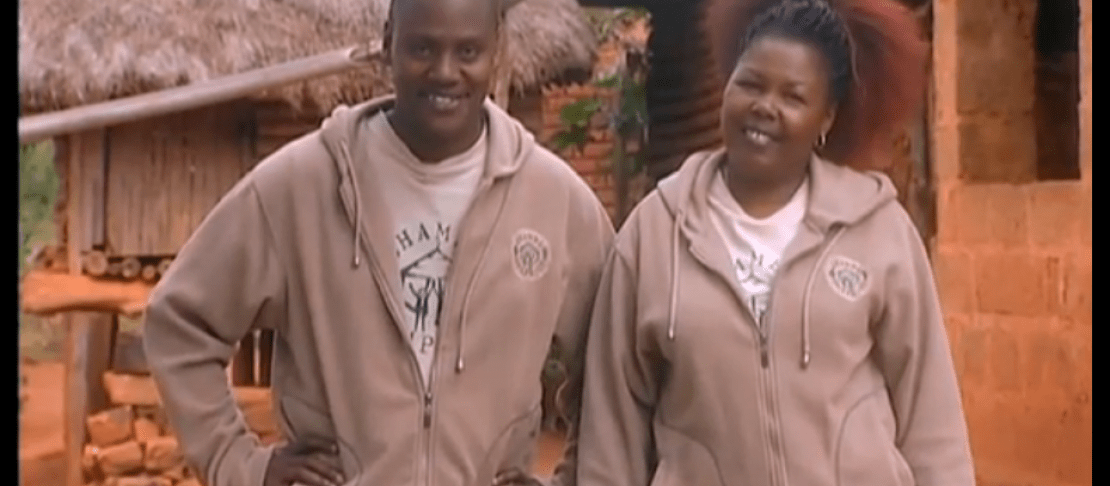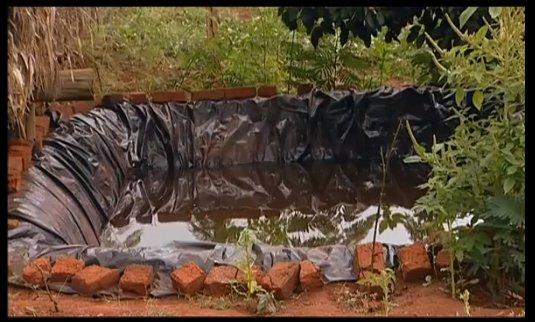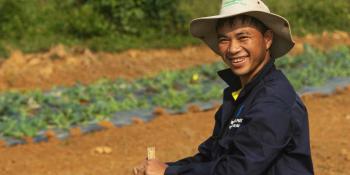These are some of the impacts an agriculture TV-show can have

Does the farm edu-tainment show Shamba Shape Up have any lasting effects on its viewers and the farmers featured in the programs?
In a recently aired episode, viewers got to follow the Shamba Shape Up team as they revisited Cecilia and Philip, a farming couple they helped a while back. Now, a few months down the road we are all ready to know: did the farm make-over show have any lasting effects on the couple's farm?
During their first visit, presenters Tonny Njuguna and Naomi Kamau, famous for their up-beat personalities and creative ideas on how to boost farm production, got to talk to Cecilia and Philip about a never-ending topic for all farmers: water.
Getting to grips with affordable water management
Machakos, the area where Philip and Cecilia live in Kenya, can get very dry, and water is a big problem. More often than not, the couple didn’t have sufficient and clean water during drought periods.

Philip and Cecilia on their farm that was in dire need of a trustworthy water source.
“We get water from dams and the nearby rivers, and when it is very, very adverse, we buy from the vendors who take it around,” Philip gravely explained to Naomi during their first encounter.
During the make-over visit, the couple learned about water management from Boniface Githai, agriculture extension officer from International Fund for Agricultural Development (IFAD). Together with the presenters, they constructed a small water pan, secured with bricks and lining, that catches rainwater.
During the re-visit, both Tony and Naomi were excited to learn how the experience with the water pan has been since they left the couple.
“We don’t go and fetch water in the dam, as now we use the water that is here” Cecilia tells Tonny and Naomi with a big smile. Tonny fills in that it must save them a lot of trips, time they can now spend on the farm, which both strongly agree on.
For them, having a nearby water pan has really helped secure their farm activities: The couple mentions that they use the pan to irrigate the trees, planted during the team's last visit.The animals are also enjoying the short-distance water source. Philip adds that he is planning to look into micro-irrigation, to water his vegetables and crops, further boosting the farm production.

Instead of having to spend a lot of time walking to various water sources, the couple are now enjoying having more time to spend on other activities, such as farming and the family.
Step-by-step illustrations with lasting impacts
Shamba Shape Up is an educational agricultural program that airs in Kenya, Uganda and Tanzania to up to 11 million people. The TV-show aims to assist small-scale farmers with recurrent agricultural challenges such as lack of water, pests and diseases on crops and animals, boost crop production, and find ways to reach markets.
Aired both in English and Swahili on the weekends, it is supported by not only us, the CGIAR Research Program on Climate Change, Agriculture and Food Security (CCAFS), but also International Livestock Research Institute (ILRI), the The International Crops Research Institute for the Semi-Arid-Tropics (ICRISAT), World Agroforestry Centre (ICRAF) and International Potato Centre (CIP). The CGIAR Centres and Programs provide information about climate-smart farm practices, the latest agriculture research and lend experts that are featured during episodes.
The show’s approach is having fun while learning. This approach goes beyond training and information sharing and includes up-beat discussions, music and lots of laughter. At the same time, the presenters make sure participating farmers feel comfortable as they place their livelihoods in the hands of the TV-show.
The objective of the program is to provide famers with the “know-how” and step-by-step illustrations on how they can improve their farm activities with few means and resources.
Many of the farming practices showcased are so called “climate-smart practices”, some of which you can find in our “Climate-Smart Agriculture Success Stories” (PDF) booklet from last year. Practices including agroforestry, integrated livestock and crop management, cross-breeding, and intercropping methods, use of fruit trees and diversification on the farm to build resilience.
View the episode when Shamba Shape Up revisits farmers Cecilia and Philip:
Trees for shade, better soil and food
Coming back to Cecilia and Philip, we see that the trees they planted together with Naomi and Tonny have grown green and tall. In a previous episode, when Tonny and Naomi met the farm couple the first time, Esther Karanja, a forestry expert with the World Agroforestry Centre (ICRAF), joined to talk about the importance of planting trees in and around the farm.
Trees on the farm have different benefits. Fodder trees can help conserve and stabilize the soil, while providing food for the animals. Fruit trees on the other hand provide nutritious food for the children, Esther explained to the farming couple.
The trees on Cecilia and Philip's farm will help protect their vegetables from flooding, and top soil being blown off during heavy winds.

Forestry expert ESTHER KARANJA talks TO about tHE IMPORTANCE OF PLANTING TREES IN AND AROUND FARMS.
Evaluating the impacts of the edu-tainment show
Cecilia and Philip both mention that the activities and information they got from experts and Tony and Naomi really helped make a difference on their farm. A few months down the line, the cows are vaccinated, the water pan is filled to the brim with water and the trees are growing steadily.
For them, the experience has been very positive. And this is also in line with a recent evaluation report (PDF) of the TV-show, which shows that farmers watching the episodes are making changes similar to the ones they see featured on Shamba Shape Up.
We believe providing the needed agriculture knowledge and know-how is one part of the puzzle, but through partnering with Shamba Shape Up, and other communication and media partners, we can reach a much higher number of farmers.
This is what makes this edutainment approach combined with innovative agriculture research a successful combo. Now the challenge is: how to get even more farmers to follow in Cecilia and Philip's footsteps!
Watch the re-cap video where you will also meet, among others, farmer Robert who received help with his chickens to create a profitable business and Cecilia who needed help with what to feed her cows. Recap: Chickens, Cows, Tomatoes
Watch the video where Philip and Cecilia meet with Tonny and Naomi for the first time called: East Coast Fever, Planting Trees and Sorghum.
All photos used are from the latest Shamba Shape Up video
Timothy Muthee is a Communication trainee with the Theme of Linking Knowledge with Action. Cecilia Schubert is a Communication Officer with CCAFS



